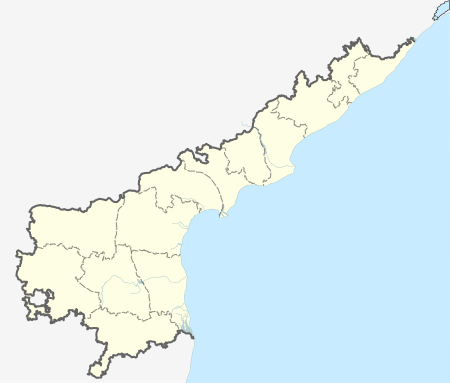Kollipara mandal
| Kollipara mandal కొల్లిపర మండలం | |
|---|---|
| Mandal | |
|
Mandal map of Guntur district showing Kollipara mandal (in green) | |
 Kollipara mandal Location in Andhra Pradesh, India | |
| Coordinates: 16°17′16″N 80°45′07″E / 16.2877°N 80.7519°ECoordinates: 16°17′16″N 80°45′07″E / 16.2877°N 80.7519°E | |
| Country | India |
| State | Andhra Pradesh |
| District | Guntur |
| Headquarters | Kollipara |
| Government | |
| • Body | Mandal Parishad |
| • Tehsildar | M.Swamy Prasad |
| Area[1] | |
| • Total | 119.75 km2 (46.24 sq mi) |
| Population (2011)[2] | |
| • Total | 56,662 |
| • Density | 470/km2 (1,200/sq mi) |
| Languages | |
| • Official | Telugu |
| Time zone | IST (UTC+5:30) |
Kollipara mandal is one of the 57 mandals in Guntur district of the state of Andhra Pradesh, India. It is under the administration of Tenali revenue division and the headquarters are located at Kollipara.[3][4] The mandal is situated on the banks of the Krishna River, bordered by Duggirala, Tenali, Vemuru and Kollur mandal.[5] The mandal is also a part of the Andhra Pradesh Capital Region under the jurisdiction of APCRDA.[6]
Demographics
As of 2011 census, the mandal had a population of 56,662. The total population constitute, 27,953 males and 28,709 females —a sex ratio of 1027 females per 1000 males. 4,486 children are in the age group of 0–6 years, of which 2,268 are boys and 2,218 are girls —a ratio of 978 per 1000. The average literacy rate stands at 72.19% with 37,663 literates.[1]
Administration
The mandal also forms a part of the Andhra Pradesh Capital Region under the jurisdiction of APCRDA.[7] It is under the control of a tahsildar and the present tahsildar is M.Swamy Prasad.[8] Kollipara mandal is one of the 2 mandals under Tenali (Assembly constituency), which in turn represents Guntur (Lok Sabha constituency) of Andhra Pradesh.[9]
Towns and villages
As of 2011 census, the mandal has 16 villages and no towns.[10][3] Kollipara is the most populated and Kunchavaram is the least populated villages in the mandal.[11]
The settlements in the mandal are listed below:
Education
The mandal plays a major role in education for the rural students of the nearby villages.The primary and secondary school education is imparted by government, aided and private schools, under the School Education Department of the state.[12] As per the school information report for the academic year 2015–16, the mandal has more than 4,504 students enrolled in over 63 schools.[13][14]
See also
References
- 1 2 "District Census Handbook – Guntur" (PDF). Census of India. The Registrar General & Census Commissioner. pp. 14,402. Retrieved 23 June 2016.
- ↑ "Census 2011". The Registrar General & Census Commissioner, India. Retrieved 12 October 2014.
- 1 2 "Guntur District Mandals" (PDF). Census of India. pp. 86,110. Retrieved 19 January 2015.
- ↑ "Adminsistrative divisions of Guntur district" (PDF). guntur.nic.in. Retrieved 12 October 2014.
- ↑ "Mandals in Guntur district". aponline.gov.in. Retrieved 12 October 2014.
- ↑ "Andhra Pradesh Capital Region Development Authority Act, 2014" (PDF). News19. Municipal Administration and Urban Development Department. 30 December 2014. Retrieved 9 February 2015.
- ↑ "District wise mandals and villages covered in Krishna and Guntur districts" (PDF). Andhra Pradesh Capital Region Development Authority. Government of Andhra Pradesh. Retrieved 23 September 2015.
- ↑ "List of Tahsildars working in Guntur District as on 19.06.2014" (PDF). Guntur District Official Website. National Informatics Centre. p. 1. Retrieved 8 September 2014.
- ↑ "Delimitation of Parliamentary and Assembly Constituencies Order, 2008" (pdf). Election Commission of India. p. 22. Retrieved 11 October 2014.
- ↑ "Kollipara mandal villages" (PDF). Chief Commissioner of Land Administration, Govt. of Andhra Pradesh. National Informatics Centre. Retrieved 12 October 2014.
- ↑ "Sub-District Details of Guntur District". censusindia.gov.in. Retrieved 12 October 2014.
- ↑ "School Education Department" (PDF). School Education Department, Government of Andhra Pradesh. Retrieved 7 November 2016.
- ↑ "R1.1 SCHOOL INFORMATION".
- ↑ "Student Information Report". Commissionerate of School Education. Child info 2015-16, District School Education - Andhra Pradesh. Retrieved 8 November 2016.
 |
Duggirala mandal | Duggirala mandal Krishna River |
Krishna River |  |
| Duggirala mandal Tenali mandal |
|
Krishna River | ||
| ||||
| | ||||
| Tenali mandal | Vemuru mandal Kollur mandal |
Krishna River |
